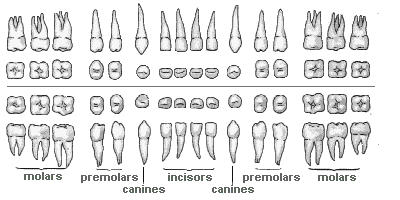
The 4 Types of Human Teeth
Humans, same as the rest of the mammals, are heterodont animals, meaning that they have several different forms of teeth. Human teeth differentiate in shape, while more primitive animals are homodont and all their teeth have the same shape possibly differing only on size.
Permanent human teeth come in four different types: incisors, canines, premolars, and molars.
Why Humans Have 4 Different Types of Teeth?
Human teeth belong to four distinct types each having a typical appearance and performing a certain function. The shape and morphology of each human tooth type depends on the function that it is assigned to perform.
As a species, humans are omnivorous eating both meats and plants, so they need different types of teeth to handle both types of food. Generally, carnivorous animals need sharp teeth to pierce and tear meat, while herbivorous animals need flat teeth to crush and grind plants. Humans, as omnivorous, must have at least these 2 types of teeth.
Through evolution humans have developed 4 different main teeth types:
1. Incisors
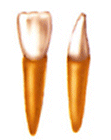 Incisors (Cutting teeth) are the teeth at the center of the dental arch. There are eight incisors in total in the permanent (and primary) dentition, two on either side (left and right) in the upper and lower jaw.
The middle four of them (one at each quadrant) are called central incisors, while the other four next to them are named lateral incisors.
Incisors (Cutting teeth) are the teeth at the center of the dental arch. There are eight incisors in total in the permanent (and primary) dentition, two on either side (left and right) in the upper and lower jaw.
The middle four of them (one at each quadrant) are called central incisors, while the other four next to them are named lateral incisors.
Incisors are flat and board, shaped like a shovel with a narrow straight cutting edge that enables them to cut food. The main functions of an incisor in the mastication process are biting, cutting of food into chewable pieces and moving it inwards the mouth.
All eight incisors have a single root and almost the same shape, but their size may differ slightly with the upper incisors usually larger, and especially the central ones.
2. Canines (cuspids)
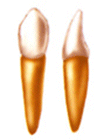 Canines (also called eye teeth or cuspids) are the teeth located next to the incisors towards the edge of the mouth. There are 4 canines in both primary and permanent human dentitions, one at each quadrant of the mouth.
They are the third teeth from the center.
Canines (also called eye teeth or cuspids) are the teeth located next to the incisors towards the edge of the mouth. There are 4 canines in both primary and permanent human dentitions, one at each quadrant of the mouth.
They are the third teeth from the center.
They have a sharp pointed edge that is used to rip and tear tough foods such as meat. In humans canine teeth have the same height as the rest of the teeth but in other animals they are longer and used to bite and kill prey. Canines have a single but long root that can reach up to 3 cm providing the stability required for their function. They are the longest and most stable human teeth.
3. Premolars (bicuspids)
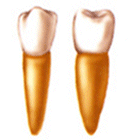 Premolars (also called bicuspids) are the teeth located after the canines towards the back of the mouth. There are eight premolars in the permanent dentition, two on either side (left and right) in the upper and lower jaw.
The front four of them (one at each quadrant) are called first premolars, while the other four on the back are called second premolars. The premolars are the fourth and fifth teeth from the midline.
Premolars are only present in the permanent dentition; there are no premolars in the primary human dentition. When they erupt, they replace the primary molars.
Premolars (also called bicuspids) are the teeth located after the canines towards the back of the mouth. There are eight premolars in the permanent dentition, two on either side (left and right) in the upper and lower jaw.
The front four of them (one at each quadrant) are called first premolars, while the other four on the back are called second premolars. The premolars are the fourth and fifth teeth from the midline.
Premolars are only present in the permanent dentition; there are no premolars in the primary human dentition. When they erupt, they replace the primary molars.
The morphology of premolars is a combination between canines and molars. They are also known as bicuspids, because usually they have at least two cusps on their upper side. Premolars have a broader surface for chewing and grinding, but they also have some sharp points for piercing and ripping at the edge of the cusps. Their major role is to begin the crushing of foods before they are transferred to the molars for the final grinding. The upper jaw first premolars have two roots, while the upper second ones and all the lower jaw premolars have only one root.
4. Molars
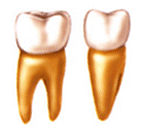 Molars are the teeth located at the back of the dental arch. Adult humans have twelve molars, three on either side (left and right) in the upper and lower jaw.
There are only 8 molars in the primary dentition which are replaced by the permanent premolars. Permanent molars are named as first, second, and third starting from the front to the back.
The third molars are also known as wisdom teeth. Wisdom teeth are the last teeth to erupt behind all other teeth at the age of 17-25 years, much later than the rest.
The molars are the sixth, seventh, and eighth teeth from the midline.
Molars are the teeth located at the back of the dental arch. Adult humans have twelve molars, three on either side (left and right) in the upper and lower jaw.
There are only 8 molars in the primary dentition which are replaced by the permanent premolars. Permanent molars are named as first, second, and third starting from the front to the back.
The third molars are also known as wisdom teeth. Wisdom teeth are the last teeth to erupt behind all other teeth at the age of 17-25 years, much later than the rest.
The molars are the sixth, seventh, and eighth teeth from the midline.
Molars perform most of the chewing, by crushing and finalizing grinding before swallowing the food.
The first and second molars have a similar shape with premolars, but they are larger (with the first molar larger than the second one). The mandibular first molars (the one at the lower jaw) are usually the largest teeth of the human mouth. They have a more flattened surface with four to five cusps, and two to three roots.
The morphology and size of third molars (wisdom teeth) may vary significantly but they are usually smaller than the other molars. In some cases they fail to erupt properly in the mouth, either remaining trapped inside the jaw bone (impacted wisdom teeth), or erupting partially causing a painful condition known as pericoronitis.

